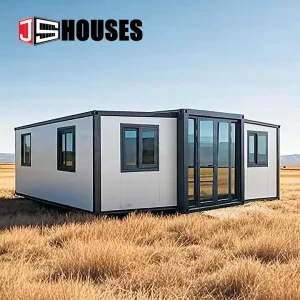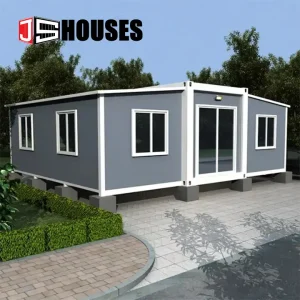The Expandable Container House: Redefining Modular Living
In the evolving landscape of modern architecture and sustainable living, the expandable container house has emerged as a revolutionary concept, marrying the robustness of industrial design with the flexibility required for contemporary life. More than just a repurposed shipping container, it is a dynamic living system designed to adapt, grow, and respond to its inhabitants’ needs. This innovative housing solution addresses critical issues of space efficiency, cost-effectiveness, and environmental sustainability, offering a compelling alternative to both traditional site-built homes and static modular units.
An expandable container house, at its core, begins as a standard ISO shipping container—typically a 20-foot or 40-foot unit. This initial module serves as a core structural unit, fully fitted with essential amenities in a factory-controlled environment. The defining characteristic, however, lies in its ability to physically “expand” or “unfold” once deployed on-site. Through various mechanical systems—such as sliding mechanisms, hydraulic pistons, or simple telescopic frames—the house transforms, doubling or even tripling its original floor area. This metamorphosis from a compact, transportable box into a spacious, comfortable dwelling is not just an engineering marvel; it is a new philosophy of living that prioritizes efficiency without compromising on space or quality.

The Engineering Behind the Expansion: How It Works
The magic of the expandable container house is in its deployment. The transformation from a transport-mode container to a fully-expanded home is achieved through several ingenious design systems:
- Sliding Box Mechanism: This is one of the most common and visually striking designs. The core container acts as a central fixed module. One or more additional segments, which are nested inside or attached to the core during transport, slide out horizontally on built-in rails or tracks. This creates additional rooms or living areas seamlessly. Once fully extended, the structure is locked into place, and the roof and walls of the extended sections are secured, creating a continuous, weather-tight envelope.
- Telescopic (Push-Out) System: In this design, the walls of the container are not fixed. Instead, they consist of layered panels. Using a manual crank, electric motor, or hydraulic system, these panels push outward, expanding the home’s width. Similarly, the roof may be raised to create higher ceilings. This system is excellent for creating a more open-plan layout from a single container unit.
- Foldable Panel System (Vertical Expansion): Some designs focus on vertical expansion. The roof, which is hinged, is lifted hydraulically or electrically, and the side walls, which were folded against the ceiling during transport, unfold downward to become vertical walls. This “pop-up” design is highly effective for creating a second story or significantly increasing the interior volume and ceiling height of a single-story unit.
Regardless of the mechanism, the process is designed for relative simplicity. The goal is to have a home that can be transported with the efficiency and low cost of a standard container truck, then rapidly deployed on-site with minimal need for heavy machinery or a large construction crew. The entire process can often be completed within a single day.

The Multifaceted Advantages: Why Choose an Expandable Container House?
The growing popularity of expandable container houses is rooted in a powerful combination of practical, economic, and environmental benefits.
1. Optimal Space Utilization and Transport Efficiency:
This is the most significant advantage. In its collapsed state, the house occupies the footprint of a standard container, making it incredibly cost-effective to ship anywhere in the world via truck, train, or ship. This solves a major logistical and financial hurdle of traditional modular homes, where oversized loads require special permits, escorts, and higher fees. Once on-site, it transforms into a dwelling with the spatial qualities of a much larger structure, effectively decoupling transport size from living size.

2. Remarkable Cost-Effectiveness:
The financial benefits are multi-layered:
- Reduced Transportation Costs: As mentioned, shipping a container is vastly cheaper than shipping a pre-built modular home of equivalent final size.
- Lower Labor Costs: A significant portion of the construction—including electrical wiring, plumbing, insulation, and interior finishing—is completed under controlled factory conditions. This “Fabrication-First” approach is faster, reduces weather-related delays, and requires fewer skilled laborers on-site.
- Material Efficiency: Using a retired shipping container as a structural skeleton is a form of upcycling, reducing raw material costs. Furthermore, the controlled factory environment minimizes material waste.
3. Unmatched Versatility and Customization:
Expandable container houses are not one-size-fits-all solutions. They can be highly customized to suit a wide array of needs and aesthetics.
- Layout and Size: Units can be combined and stacked. Multiple expandable containers can be linked to create large, complex residences, offices, or multi-unit apartment buildings.
- Interior Finishes: Clients can choose from a range of interior styles, from industrial minimalist to rustic wood-clad or modern luxury. The placement of kitchens, bathrooms, bedrooms, and living areas is tailored to the owner’s requirements.
- Off-Grid Capability: These houses are ideal for remote locations. They can be pre-fitted with solar panels, rainwater harvesting systems, composting toilets, and advanced battery storage, making them fully self-sufficient.
4. Inherent Sustainability and Durability:
In an era of heightened environmental consciousness, the expandable container house stands out.

- Upcycling: It gives a new life to a steel structure that would otherwise sit idle in a port, reducing the demand for new steel and the associated carbon footprint of its production.
- Reduced Site Disturbance: The rapid, dry-construction deployment causes minimal disruption to the building site, preserving the local ecosystem.
- Energy Efficiency: The factory setting allows for the installation of high-performance insulation, energy-efficient windows, and tight sealing, resulting in a thermal envelope that often surpasses that of traditionally built homes. This leads to lower energy consumption for heating and cooling.
5. Speed of Deployment and Mobility:
For applications requiring rapid establishment of facilities—such as disaster relief, construction site offices, or tourist camps—the speed is unparalleled. A fully-equipped dwelling can be delivered and made operational in a matter of days. Furthermore, while not designed for frequent moving, the houses are inherently relocatable. They can be collapsed back into their transport mode and moved to a new location, offering a unique form of long-term mobility.
Applications and Use-Cases: Where Expandable Container Houses Shine
The flexibility of this building type allows it to serve a diverse range of purposes:
- Residential Housing: As primary homes, vacation cabins, or backyard accessory dwelling units (ADUs), they provide affordable, stylish, and efficient living spaces.
- Commercial and Civic Use: They are increasingly used as pop-up retail stores, modular offices, school classrooms, medical clinics, and community centers.
- Emergency and Humanitarian Aid: Their ability to be shipped quickly and set up with minimal tools makes them ideal for providing dignified temporary shelter, field hospitals, and command centers in disaster zones.
- Tourism and Hospitality: Eco-resorts and glamping sites utilize them to create comfortable, low-impact accommodations in sensitive natural environments.
Challenges and Considerations
Despite the numerous advantages, potential adopters must be aware of the challenges:
- Insulation and Condensation: The steel structure is highly conductive, making superior insulation critical to prevent thermal bridging, condensation, and uncomfortable interior temperatures.
- Maintenance of Moving Parts: The expansion mechanism requires periodic inspection and maintenance to ensure long-term reliability and weatherproofing.
- Permits and Regulations: Navigating local building codes can be complex, as some jurisdictions may not have specific regulations for this emerging building type. Early engagement with local authorities is essential.
- Perception: Overcoming the industrial “shipping container” aesthetic may require thoughtful architectural design and cladding for some clients.
Conclusion: The Future of Housing is Adaptive
The expandable container house is more than a clever architectural novelty; it is a testament to human ingenuity in the face of global challenges like urbanization, housing affordability, and environmental sustainability. It successfully challenges the conventions of static, resource-intensive construction by offering a system that is mobile, efficient, and adaptable.
By mastering the art of transformation—compressing for economy and expanding for livability—it delivers the best of both worlds. It represents a future where our homes are not permanent, immovable burdens on the landscape, but dynamic, responsive partners in our lives, capable of changing as our needs change. As technology advances and designs become even more sophisticated, the expandable container house is poised to move from the fringe to the forefront of sustainable, intelligent architecture.

